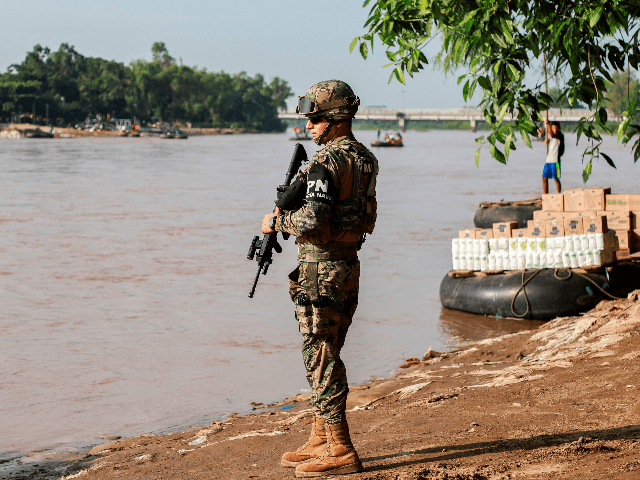President Donald Trump’s high-pressure migration deal with Mexico’s government is shutting down migration from Guatemala for now, according to a report in the Wall Street Journal (WSJ).
“The road is hard in Mexico now,” one smuggler told the Journal‘s reporter. “There are many checkpoints [in Mexico]. For now, nobody is moving. People will wait a couple of months.”
Guatemala’s downturn is helping to reduce the number of migrants caught and released at the U.S. border. Breitbart News reported July 25:
Between July 10 and July 22, DHS released about 2,500 border crossers and illegal aliens into American communities, federal data confirms. This indicates that DHS is releasing about 192 border crossers and illegal aliens every day into the country, a reduction of about 85 percent compared to catch and release totals weeks before the Trump-Mexico deal.
But Trump’s gains in Mexico come as a progressive judge in California has temporarily blocked recent asylum reforms, and as the Guatemalan government backed out of negotiations to create a “Safe Third Country” deal with the United States.
The WSJ claim matches other reports of border crackdowns in Mexico. A Jesuit publication, America, reported July 24:
MEXICO CITY (CNS) — Soldiers appeared recently at the diocesan migrant shelter in the northern Mexican city of Saltillo and demanded to see the identifications of its guests.
Shelter director Alberto Xicotencatl raced into the street to confront the soldiers July 23, according to video shared on social media. He shouted that Mexican law forbids demanding immigration documents from any person at a migrant shelter or within a three-mile radius of such places.
He added, “There’s no other explanation” for the army’s visit — and one by the federal police three days earlier, when they, too, asked to check migrants’ documents.
…
At the shelter in Saltillo, some 185 miles from the U.S. border at Laredo, Texas, Xicotencatl said increased enforcement and measures such as bus companies demanding immigration documents from passengers has sent the guest count plunging from 400 people per day in early June to just 80 people per day now.
The Center for Immigration Studies reported July 23:
the Honduran news publication La Prensa reported [July 10] that Mexico’s National Institute for Migration (INM) conducted an enforcement operation near the U.S.-Mexico border. Federal police detained a private tour bus on the Torreron-Saltillo highway in Coahuila and 91 Central American migrants were apprehended. Of those migrants, 60 were Honduran and 31 were Salvadoran. The migrants were detained and transported to a temporary shelter until a deportation date can be set.
…
Telemundo reported [on July 3] the repatriation of nearly 70 Central American migrants in Ciudad Juarez. The nationalities of that group were 40 Hondurans, 22 Guatemalans, and 7 Salvadorans. All but three of the migrants had applied for asylum in the United States. Recently, the Mexican Ministry of Foreign Affairs and the INM implemented a temporary “Voluntary Return Program” in Ciudad Juarez. This allows migrants to return to their home countries’ at their discretion, while awaiting the outcome of their asylum claims in the United States.
According to INM, Mexico deported 21,912 migrants in June, an increase of 32.7 percent from the previous month.
The WSJ article explained why so many Guatemalans made a rush for the U.S. border since October 2018, saying:
Guatemala is now the largest source of illegal immigrants coming to the U.S. Apprehension of Guatemalans jumped to about 236,000 in the first nine months of fiscal year 2019 from about 15,000 in 2007, according to U.S. government data.
…
A 2015 U.S. federal court ruling made it easier for migrant families with children to apply for asylum and stay in the U.S. until their cases are decided by a judge. After the ruling, many more families with children began turning up at the U.S. border. President Trump wants Congress to pass a law eliminating what he sees as a loophole in the law.
Second, a yearslong drought has shrunk corn and bean harvests. The manager of a bank in Joyabaj specializing in agricultural loans said they have reduced loans to local farmers by 60% over the past six years and now lend only to those who already have their own irrigation systems. Separately, coffee prices have fallen, hurting growers and killing many seasonal jobs.
Finally, there was Mr. Trump. The president’s promise to build a wall along the U.S.’s southern border led many Guatemalans to conclude they should leave now—or risk getting shut out of the U.S. for good.
On Tuesday, Trump slammed Guatemala’s government for backing out of the draft asylum reform deal:
Guatemala, which has been forming Caravans and sending large numbers of people, some with criminal records, to the United States, has decided to break the deal they had with us on signing a necessary Safe Third Agreement. We were ready to go. Now we are looking at the “BAN,”….
— Donald J. Trump (@realDonaldTrump) July 23, 2019
….Tariffs, Remittance Fees, or all of the above. Guatemala has not been good. Big U.S. taxpayer dollars going to them was cut off by me 9 months ago.
— Donald J. Trump (@realDonaldTrump) July 23, 2019
If the agreement had been signed, it would have the given U.S. border officers the legal authority to quickly repatriate migrants who pass through Guatemala, despite the catch-and-release loopholes created and preserved by the U.S. Congress and courts. In effect, the deal would have created a legal wall against Latin American, African, and Indian migrants who pass through Guatemala.
The court decision in California will likely be appealed to the Supreme Court.

COMMENTS
Please let us know if you're having issues with commenting.